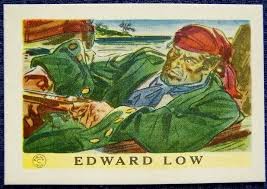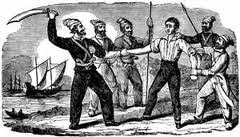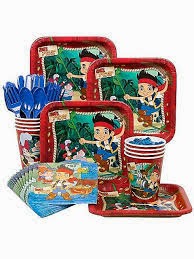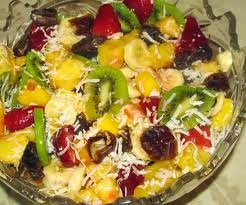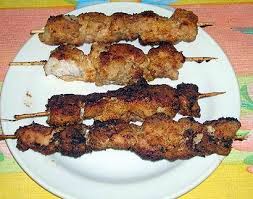Warning - Not for the Squeamish.
Anyone who reads this blog regularly knows that I don’t think most pirates were evil. Pirates – especially during the Golden Age – were men who had given up on an employment system that was vastly unfair to them, and simply refused to abide by the rules that oppressed them. They didn’t get an “evil card” when they became pirates. Instead, their essential likes, dislikes and temperaments remained the same.And because of this, pirates tended to like and to do the same things most sailors did. They liked flashy clothes and good food, and tended to drink too much and spend money on pretty women.
But there was definitely a darker side to the pirate life. There was literally no punishment worse than the one for piracy. And so these men were free from all the constraints of law and order. Every man who became a pirate was under a death sentence as soon as he robbed his first ship. And since he could not face any worse punishment, there was no reason not to rape, kill or torture, if the mood took him.
It’s a tribute to the general moral goodness of humanity that most pirates were well behaved.
Most of the mayhem caused by early pirate captains was aimed at races or cultures other than their own. The 1600’s were an age of religious wars and extreme xenophobia. Religious and political leaders defined people of other religions or cultures as sub-human, and they were believed by the masses.

When men like Henry Morgan confronted the Spanish he was meeting Catholics, and as a Protestant he had no reason to think of them as in any way like himself. So Morgan, a friendly man, loved by his crews and comrades, made a career of destroying Spanish towns, looting, burning, pillaging and raping. He destroyed Panama City so utterly that it was rebuilt in a different location (its present one). Morgan and his men tortured the Spanish citizens to persuade them to give up their treasures. Morgan carried out his missions against any Spanish town that seemed convenient, whether he had official permission from his government to do so or not.
When back in port, among his own people, he was a peaceful if somewhat rough-hewn gentleman.
French pirate François l'Olonnais had a personal vendetta against the Spanish, as they wiped out almost all of his crew during his early career. L’Olonnais only survived by covering himself in the blood of his slaughtered men and hiding among the dead. After that, he burned all the Spanish ships he captured.
One crew of a Spanish naval ship was entirely beheaded. L’Olonnais left one man alive and sent him back to the Spanish government with a warning.
When he sacked the Spanish town of Maracaibo, he found that most of the inhabitants had hidden their valuables and fled. The pirates tracked down the citizens and tortured them until they revealed the locations of the money. L’Olonnais was an expert torturer, who favored cutting pieces off his victims with a sword, tightening rope around their heads until their eyes popped out, and tying burning rope to their hands.
When l’Olonnais’ crew took the Venezuelan town of Gibraltar, his men slaughtered the garrison, held the town for ransom, and when the ransom was paid, stayed in the town for over two months, raping, burning and pillaging. The town was effectively destroyed. In the next 350 years it has never recovered.
When faced with near-capture, he and his men caught several Spanish soldiers, and needed to persuade them to reveal the safest escape route. L’Olonnais wasted no time. He hacked one soldier’s living heart out of his chest and ate it in front of the dying man’s eyes. The rest of the soldiers were happy to cooperate with the pirates.
During the Golden Age, pirates dedicated to finding justice for oppressed sailors (including themselves) set up courts of honor to punish merchant captains who had mistreated their crews, and the fate of these men could be dire. One captain who had formerly refused to pay his crews found himself tied to the capstan and pelted with broken bottles. Finally, when he was terrified and streaming blood, a member of his former crew stepped up to him, told him that he wasn’t such a bad fellow, and shot him in the head. He died instantly.
Other men were forced to run around the base of the ship’s mainmast while the pirate crew stabbed at them with knives, forks, compass cases, pen-sharpeners and swords. The buttocks were the favored target, but such abuse could still do substantial damage.
Some merchant captains were hanged from their own yardarms.
The most notorious of the Golden Age pirates was probably Edward Low, a former pickpocket and strong-arm thief who went to sea in his late teens. Low was probably a sociopath, who used his love of torture to improve his reputation as a bloodthirsty marauder. By leading an attempted mutiny, Low took his career straight from deck-hand to captain. His own men described him as “a maniac and a brute.”
His most famous action was cutting a Portuguese captain’s lips off, cooking them, and forcing their owner to eat them.
He burned a French cook alive, saying “He’s a greasy fellow who will fry well.”
Low also liked to torture victims, often for no particular reason. He counted on his reputation creating so much terror that the crews of merchant, and even navy ships would be too frightened to attack him. When the authorities placed a huge bounty on his head, the Caribbean became too hot, and Low moved his operations north to attack the New England whaling fleet.
He immediately began by torturing and murdering the captain of a whaler, and went on wreaking havoc among the fishing ships until his own crew refused to sail with him, and put him off in a smaller boat.
Low’s ultimate fate remains uncertain. Some sources say that his own (smaller) crew eventually killed him over his murder of one of his own men. Others think that he went down in a storm, or was caught by the French and hanged in Martinique. There is even some evidence that he landed on the coast of Brazil and lived his life out there, though this seems unlikely for such a violent man.
The seventeenth and eighteenth centuries were a bloody and violent time, and pirates like these made it more so. But it’s important to remember that, even among their own law-breaking comrades, they were exceptions to the rule. Pirates were human, just like the rest of us, with a wide variety of personalities and behaviors.




